Bulletin – July 1995 Quarterly Report on the Economy and Financial Markets
- Download 236KB
Introduction
Indications of more moderate growth in the Australian economy have continued to emerge over recent months. According to the latest national accounts, real non-farm GDP recorded growth of about 5 per cent in the year to the March quarter, but growth in the second half of that period was noticeably slower, at around 3 per cent.
As in all moderate business cycle slowdowns, different sectors of the economy are experiencing different conditions, and the various indicators are giving mixed signals. Residential construction, after a prolonged period of strength, is falling back to lower levels. Non-residential construction, on the other hand, is increasing. Manufacturers in several areas are facing more difficult conditions, but service industries have continued to expand. To date, the slowing in growth has not been reflected in reduced labour hiring – if anything, employment growth has picked up in the first half of 1995, and unemployment has fallen further. Some slowing in employment growth can be expected in coming months, however, and this seems to be foreshadowed by the vacancies statistics.
Looking ahead, the rural sector generally is likely to experience much better conditions over the coming year, and the resource sector will enjoy higher prices for coal and iron ore. Stock levels have risen above desired levels and output in some areas could be held down over coming months as this excess is worked off. Today's inventory management practices, however, have kept the build-up – and so the size of the required adjustment – smaller than in previous cycles. Consumer demand has remained quite robust, and confidence has steadied at what is historically a high level. Imports, particularly of capital and intermediate goods, have continued to grow strongly. Business sentiment, especially but not exclusively in manufacturing, has weakened over recent months, in part because of slower growth in demand but also because production costs have increased. Business investment intentions, on the other hand, at least at this time, remain quite strong.
Overall, growth appears to have been running at a rate of 3–4 per cent, which is in line with the sustainable growth path for which policy has been aiming. This process of adjustment – from unsustainable to sustainable growth paths – is rarely achieved smoothly or precisely, and it is possible that growth could slow further over coming quarters. There is no reason, however, to expect a major slump in activity to originate from domestic sources in the year ahead; indeed, growth could easily bounce back again as 1995/96 progresses.
The external environment poses some question marks for activity. Growth in the US economy has slowed quite quickly, and the short-term outlook for Japan has worsened. While growth in the other east and south-east Asian economies continues to be robust and should offer good opportunities to exporters, trends in the two largest economies need to be watched closely; the recent reductions in official interest rates in those two countries are, at the margin, positive developments.
Changes in the international climate are influencing Australian financial markets. Yields on US securities have fallen sharply as markets anticipated the recent easing in US monetary policy. This has been echoed in Australian markets, with yields on Australian bonds and domestic short-term securities declining as markets reassessed the likelihood of any further rises in official interest rates. For the exchange rate, these international influences have been less favourable. Assessments that growth abroad was slowing have brought to an end the rise in commodity prices, reducing support for the Australian dollar. At the same time, concerns about the current account have intensified on the back of some large monthly numbers. By the end of June, sentiment towards the exchange rate had turned bearish, pushing the $A to its lowest levels since late 1993.
The decline in the exchange rate over the past six months is adding appreciably to costs at the wholesale level, and these can be expected – with a lag – to feed into prices for final goods. Domestic pressures on costs and prices are also continuing for the time being, with some producer price series rising by 4 per cent or more over the past year, and some measures of labour costs by 4–5 per cent over the same period. These pressures come from a variety of sources, some of which are related to the earlier period of very strong domestic growth. The slower growth now in prospect is likely to moderate future rises, but the working out of the pressures already in the pipeline is expected to result in a cyclical increase in underlying inflation over the next year. In this environment, the Bank believes that official rates should be maintained at their present levels for the time being.
Economic Activity
The latest national accounts showed growth in real GDP of 0.5 per cent in the March quarter, and 3.7 per cent in the year to March. Non-farm GDP was 5.0 per cent higher in March than a year earlier, but the rate of expansion over the second half of that period was a good deal slower than in the first half (see Graph 1). This broad pattern is consistent with other information which has been suggesting for some months that the economy, while still growing, is doing so at a reduced pace.
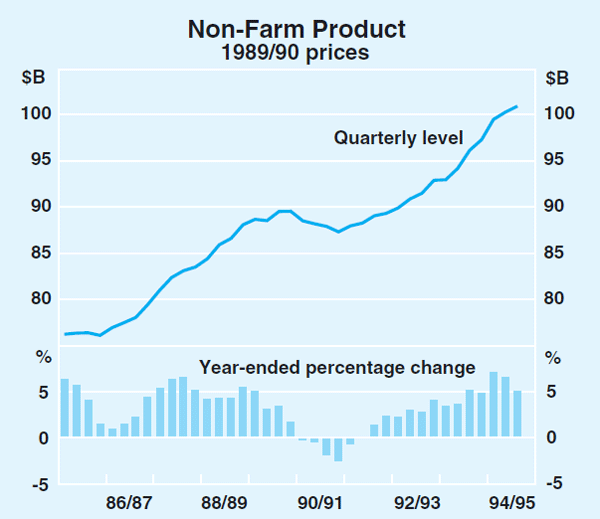
Assessing the likely extent and longevity of that slowing from the national accounts is difficult, given that, over the past year, the three measures of output growth have diverged significantly (see Table 1). The picture is further complicated by the fact that some other indicators of economic activity – imports, and particularly employment – have not, to this point, exhibited clear signs of a slowing. In general, however, the best assessment appears to be that growth is running at a rate close to (or even possibly slightly below) the economy's likely potential growth rate of 3 to 4 per cent, whereas six to nine months ago it was unsustainably fast.
| 6 mths to Sep quarter 1994 |
6 mths to Mar quarter 1995 |
Year to Mar quarter 1995 |
|
|---|---|---|---|
| Private final demand* | 4.9 | 1.6 | 6.6 |
| GNE | 3.5 | 1.7 | 5.4 |
| Non-farm GDP(A) | 3.5 | 1.5 | 5.0 |
| GDP(A) | 2.6 | 1.1 | 3.7 |
| of which: GDP(E) | 1.4 | 1.2 | 2.7 |
| GDP(I) | 2.8 | 1.0 | 3.8 |
| GDP(P) | 3.6 | 1.2 | 4.8 |
| * Excluding transfers to and from the public sector. | |||
The household sector
Growth in private consumption has continued to be quite robust. Private consumption rose by 0.8 per cent in real terms in the March quarter, to be 4.7 per cent higher than a year earlier. More recent indicators suggest that this growth has continued (see Graph 2). Monthly data on retail trade have been volatile, but taking March, April and May together, the value of retail trade was some 2 per cent higher than in the preceding three-month period, and 8 per cent higher than in the corresponding period a year earlier.
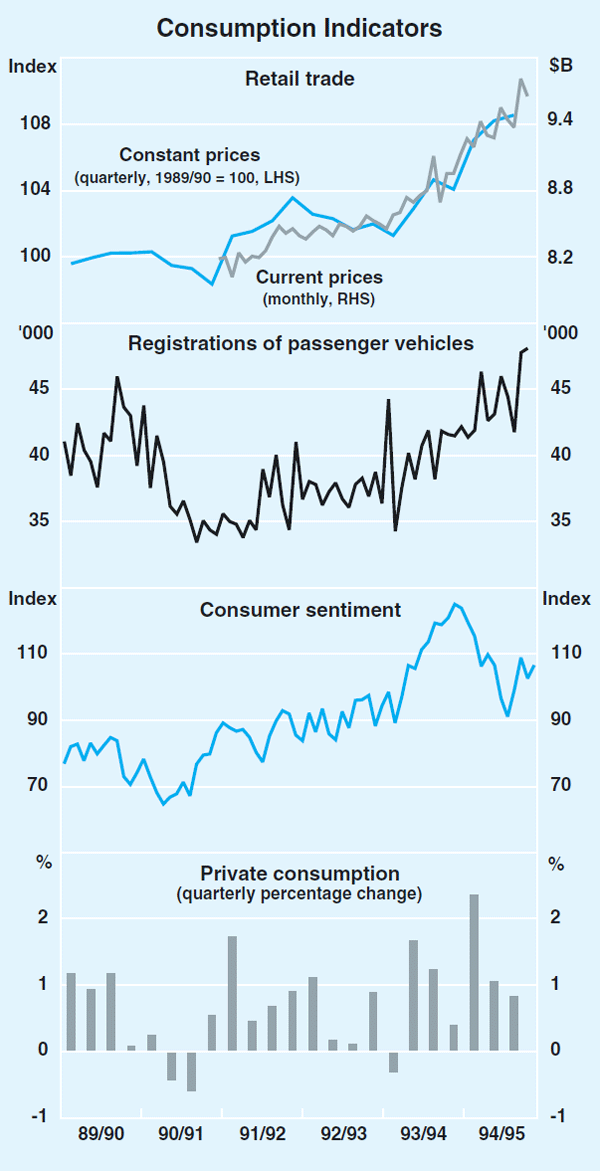
Data on passenger vehicle registrations have also been volatile but, on average, quite strong. For the three months to May, passenger vehicle registrations were 3 per cent higher than in the preceding three months and 13 per cent higher than a year earlier. These results may have been affected by the sales tax change announced in the May Budget, which could have brought forward some sales. For that reason alone, vehicle sales could fall off in the second half of 1995.
Overall, the expansion in consumption has run ahead of income growth over the past year. Solid growth has occurred in wage incomes but there was little growth in unincorporated enterprise income (partly as a result of falling farm incomes), so that growth in overall household disposable income has lagged. The estimated household saving rate has fallen to around 3 per cent.
Barring a major deterioration in employment prospects, there is likely to be solid growth in household incomes in the coming year, from rising wages and a recovery in the farm sector. Consumption growth over the year ahead is expected to be below the exceptional growth recorded in 1994/95, but a solid expansion in consumer spending is still likely even with some increase in saving rates.
Current indicators of consumer sentiment, such as the Westpac-Melbourne Institute index, suggest that confidence has stabilised, and even increased a little over recent months. Recent levels are well below those seen in mid 1994, but close to those of the period of strong growth in the late 1980s. In part, the recent rise in consumer confidence appears to be attributable to strong employment growth and a scaling back of earlier expectations about future interest rate increases.
Dwelling investment is clearly in the downward phase of its cycle. The value of approvals of new housing loans for owner-occupation fell by 9 per cent in the three months to April, to be 26 per cent lower than in the same period a year earlier. However, preliminary information available to the Bank suggests little change in approvals occurred in May.
Dwelling commencements fell by 13 per cent in the March quarter, following a 4.4 per cent fall in the December quarter. The March quarter outcome was driven by a 10 per cent fall in commencements of houses and a 19 per cent fall in commencements of medium-density dwellings. Building approvals data for March through to May show a 12 per cent fall compared with the preceding three months, and imply a further large fall in dwelling commencements in the June quarter (see Graph 3).
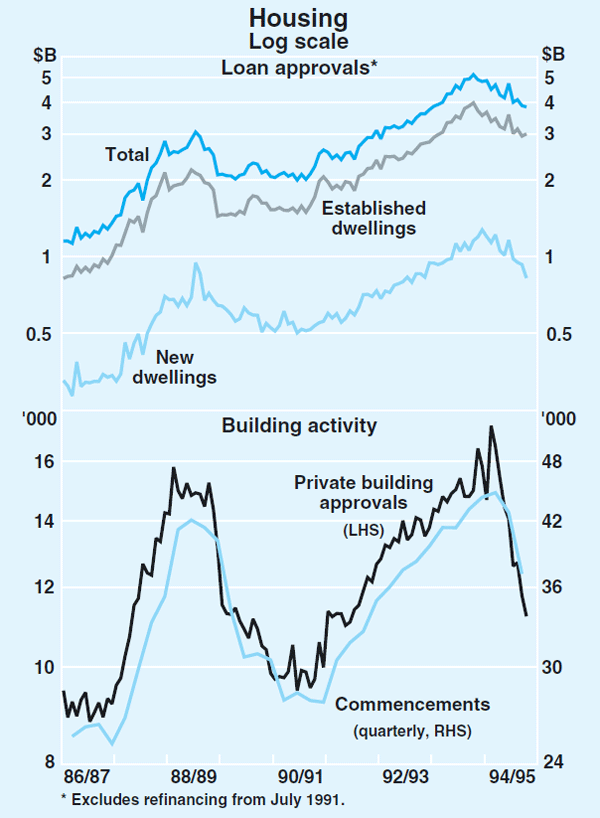
This downturn in housing construction comes after the exceptionally high levels of the past couple of years. Even now, numbers of commencements are barely down to the best available estimates of the ongoing demand for residential accommodation based on demographic trends. This suggests that housing activity could keep falling for some time yet. Judging from the finance approvals data, demand by owner-occupiers has fallen noticeably more than that by investors. Finance for investment in rental properties has fallen somewhat, but appears to be continuing at a high level at present, perhaps spurred on by low rates of vacancies in the rental housing segment in some locations.
Business conditions
Conditions for many businesses have become more difficult in recent months. With the growth in sales slowing and firms' costs increasing faster, it has become more difficult for many firms to sustain the expansion in profits seen earlier in the cycle. Reflecting this, private corporate gross operating surplus (GOS) in the national accounts fell by 2 per cent in the six months to the March quarter, following growth of 7 per cent in the preceding six months. Corporate interest payments are a little higher than a year ago but remain quite low when viewed over the past decade. Overall, the level of company profitability, and the share of profits in nominal national income, remain quite high by historical standards.
In some areas, however, profit margins are starting to be squeezed. In manufacturing in particular, cost pressures have picked up as a result of higher material and labour costs (see the section on ‘Inflation Trends and Prospects’ for details), but output prices have risen less quickly than costs. Manufacturing has enjoyed very strong growth over recent years – its output and productivity growth rates, for example, have been considerably stronger than the economy-wide average, and export performance has been remarkably strong – but business surveys suggest it is now slowing noticeably. This slowing is most pronounced, as would be expected, in areas supplying the housing industry.
Confidence in the manufacturing sector appears to have receded sharply, with the latest ACCI-Westpac survey recording the weakest outcomes for several years. New orders, output, profits and overtime were reported to be weaker in the June quarter, and generally weaker than expected at the time of the previous survey in March. The profit outlook also has declined sharply in recent quarters. In business more generally, confidence appears to have weakened further in recent months, but not by as much as in manufacturing.
Business investment spending has continued to expand (see Graph 4). In the March quarter, private equipment investment rose by nearly 2 per cent (abstracting from transfers to and from the public sector and lumpy items). This increase in investment is weaker than that shown by indicators of the supply of investment goods, such as underlying capital imports (which rose by 12 per cent in the quarter) and manufacturers' sales of industrial machinery and equipment (which rose by around 7 per cent). Since its trough in September 1992, equipment investment has been growing at an average annual rate of around 18 per cent, rising from 5½ per cent of GDP to nearly 7½ per cent (although this is still a little below levels recorded in the late 1980s).

The latest capital expenditure survey suggests that equipment investment will rise in the June quarter, and that growth for the 1994/95 year is likely to be close to the original Budget forecast of 18 per cent. Equipment investment is likely to rise further during 1995/96, although at a slower pace. The latest ABS capital expenditure survey of investment intentions reported upward revisions to planned investment, with the second reading for investment intentions in 1995/96 16 per cent higher than the first (quite weak) reading reported three months earlier, and 7 per cent higher than the corresponding reading for 1994/95, a year earlier. Implementation of these plans would take investment to levels consistent with a significant lift in the stock of business sector equipment capital.
At the same time, there are now clear signs of a recovery in expenditure on non-dwelling construction, which to this time has remained quite subdued, some 30 per cent below its 1989 peak. In underlying terms, non-dwelling construction rose by over 8 per cent in the March quarter. Several large projects are currently under way and are contributing to this pick-up. (These projects include the Melbourne Casino, the M2 motorway in Sydney, a number of major shopping centres and a gas pipeline; recent approvals include the $550 million Sydney Casino project.) Big-ticket items apart, construction activity still looks set to pick up.
One area of weakness in the short term is the emergence of a build-up in stocks over the past six to nine months. While the rate of growth in wholesale and retail trade stocks has slowed sharply, the rate of growth of manufacturers' stocks has continued to rise. As most business surveys have been suggesting that producers had in fact intended to reduce their stock holdings in recent quarters, there appears to be an involuntary element in recent stock movements. A correction to this has already commenced; in the March quarter expenditure accounts, for example, slower stock accumulation reduced growth in real GDP by 0.7 of a percentage point. Even so, the aggregate ratio of stocks to sales in the non-farm sector remained slightly above trend, which suggests that businesses will seek a further slowing in stock building in coming months. The dynamics of the stock cycle are likely to be considerably less important in driving the overall cycle in production than in the past, however, because modern inventory management practices have prevented a large build-up in unwanted inventories to the extent seen in some past cycles.
The rural sector
At least in some areas the drought is abating and a recovery in the rural sector is under way. Widespread rain received over recent months has helped grain plantings, though good follow-up rains will be required if yields in the rural sector are to return to ‘normal’. Currently, 60 per cent of NSW and 35 per cent of Queensland remain drought-declared, but these are down on the figures of several months ago.
The Australian Bureau of Agriculture and Resource Economics (ABARE) reports that crops planted last summer, such as cotton, rice and sorghum, have experienced favourable seasonal conditions. While the cotton and rice areas sown have fallen from last year, yields are expected to be considerably higher. The sorghum crop is estimated to be slightly higher than in the previous year and this should limit the need for further feedgrain imports. For winter crops, the latest ABARE forecasts are for a wheat crop of 16 million tonnes in 1995/96, up from just 9 million tonnes in 1994/95. The barley crop is forecast to be double that of last season.
A strong rural recovery would provide a significant boost to the economy in the second half of 1995/96. A return to pre-drought production levels would, at current prices, see farm incomes rise by more than 50 per cent.
Public finance
The Commonwealth Budget for 1995/96 provides for a sizeable improvement in the budget balance, from a deficit of $11.6 billion in 1994/95 to a small surplus in 1995/96. Larger surpluses are projected in following years. As a proportion of GDP, the total Public Sector Borrowing Requirement is estimated to fall by more than 2 per cent in 1995/96, to less than ½ per cent.
The Budget contains a mix of revenue and spending measures and asset sales to reduce borrowing. Excluding major asset sales, State debt repayments and some other items of a financing nature, the Budget deficit is estimated to be around 1½ per cent of GDP in 1995/96, compared with an estimated outcome on the same basis in 1994/95 of about 3 per cent of GDP. This is a substantial change in one year. In the same ‘underlying’ sense, the Budget is expected to move into surplus in coming years (see Graph 5).
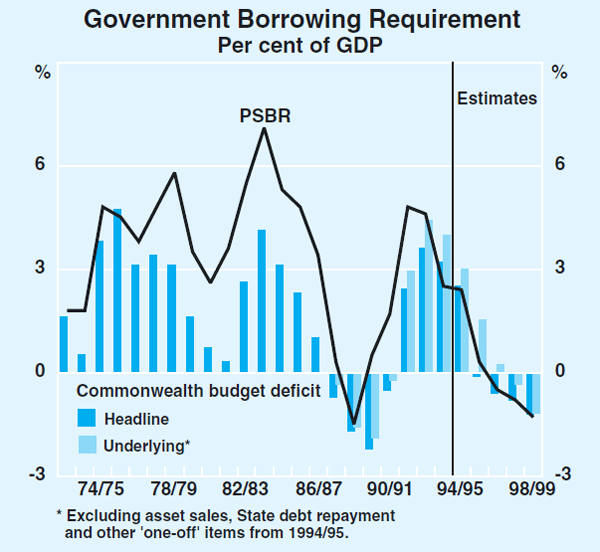
More than half of the expected improvement in the underlying deficit from 1994/95 to 1995/96 comes from on-going economic growth and previously announced measures. Measures announced in this Budget are estimated to reduce the deficit by some $2½ billion, and are likely to be mildly restrictive, in contrast to the 1994/95 Budget which (together with other policies announced at that time) was mildly expansionary. The bulk of the measures in the 1995/96 Budget come from the revenue side and include rises in some existing taxes. The remaining measures largely reflect projected savings on labour-market programs and improvements in the efficiency of the public sector. These savings are expected to carry over into future years.
The restrictive stance by the Commonwealth is not being matched by all the States. State budgets suggest that there will be a further increase in spending by a number of the States in 1995/96 including infrastructure projects.
The net effect on public saving of Commonwealth Budget measures appears to be about 1 per cent of GDP per annum on an on-going basis. This will be supplemented by the decision to pursue a phased introduction, beginning in 1997/98, of employee contributions to superannuation, which will reach 3 per cent of earnings when fully implemented. These payments will be matched by government payments for low- and middle-income earners in lieu of the second instalment of tax cuts announced in 1992 and scheduled to take effect in 1998. These initiatives, together with the superannuation arrangements already in place, could raise national saving substantially by the early years of the next decade.
External Developments
International economy
In the United States, growth in real GDP in the March quarter was 2.7 per cent (annual rate), compared with 5 per cent in the December quarter and 4 per cent for 1994 as a whole. The slowdown has since become more pronounced, particularly as production has eased back in response to weak sales in order to limit the build-up in inventories. Industrial production fell in each of the three months to May, and capacity utilisation has fallen by almost two percentage points from its peak. Real retail sales fell slightly in April and May. In the labour market, non-farm employment increased by an average of about 60,000 per month in the June quarter compared with 226,000 in the March quarter (see Graph 6). The unemployment rate has risen slightly to 5.6 per cent.

Inflation appears to have edged up a little in recent months, with the core Consumer Price Index rising by 3.1 per cent over the year to May, and at a rate slightly faster than this during the first five months of 1995. Wage costs are rising more slowly than prices, with average hourly earnings increasing 2.7 per cent in the year to May. The Federal Reserve lowered the Federal funds rate by 0.25 per cent to 5.75 per cent on 6 July, stating that inflationary pressures had receded enough to accommodate a modest adjustment to monetary conditions.
With the slowing in growth, the possibility of a mild outright contraction of the US economy has increased, particularly given the run-up in inventories. At the same time, however, the risk of a bigger downturn later, associated with a build-up in inflationary pressures and other imbalances forcing a sharper tightening of macroeconomic policies, has receded. This improves the prospects for growth in 1996. Already, falling long-term bond yields have led to lower mortgage interest rates, and hence more favourable conditions in the residential housing market. Consumer sentiment also remains at high levels.
In Japan, on the other hand, the incipient recovery appears to have lost momentum. Real GDP increased by 0.1 per cent in the March quarter and was little changed from a year earlier. Government consumption, business investment and housing construction showed positive growth but government investment fell further. More recent indicators suggest weaker economic performance. Industrial production, which was the one major indicator to show solid growth in 1994 and early 1995, turned down in April and May (see Graph 7); further falls in June and July are expected. The Tankan survey of corporations conducted by the Bank of Japan in May indicated that business sentiment has improved slightly across all industries, but retail sales continue to decline, despite tax cuts and lower prices which have improved consumers' purchasing power. Share prices have fallen, and concerns have increased over the bad debt position of the banks, notwithstanding a recent initiative to address this situation.
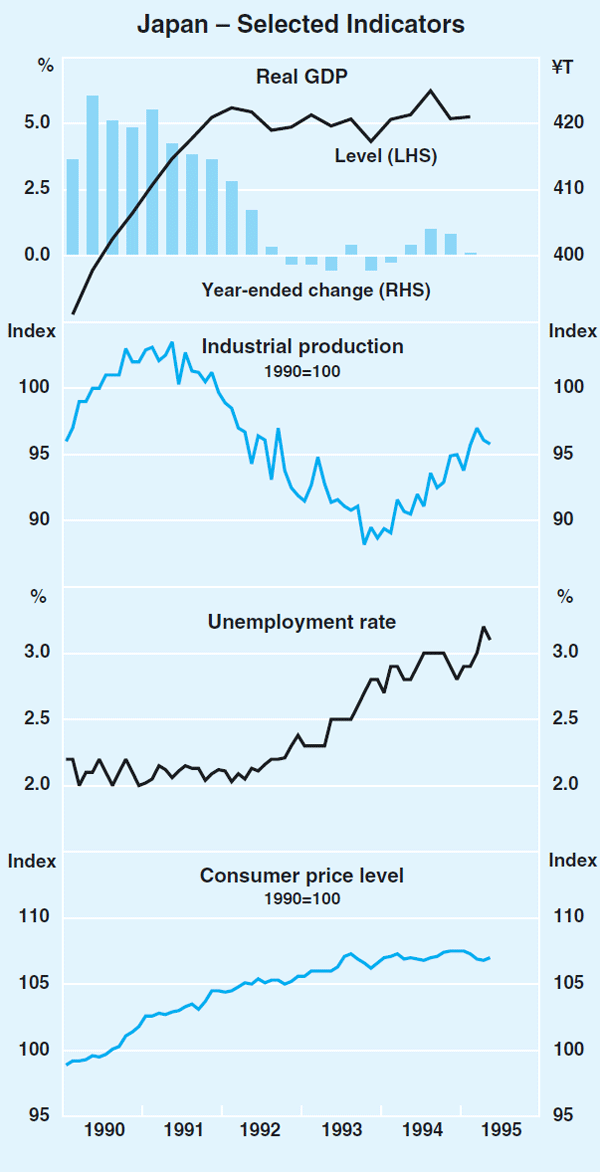
The Bank of Japan reduced short-term interest rates in April and again in early July, with the overnight call rate falling below 1 per cent, an historical low. Two fiscal stimulus packages have been put in place since March. Recovery in Japan is still being hampered, however, by the strength of the yen, continued industrial restructuring, the weakened condition of the financial sector and the associated low levels of confidence.
The strength of the yen has provided a boost to competitiveness for non-Japan East Asia. GDP in both South Korea and Malaysia increased by about 10 per cent in the year to the March quarter, while in Taiwan, output grew by 7 per cent (Table 2). The Bank of Korea has recently revised its forecast for 1995 GDP growth to 9 per cent, up from the earlier forecast of 7.3 per cent. In these countries, the current pace of expansions generally exceed estimates of long-term sustainable rates of growth, raising the risk of increased inflationary pressure if they are sustained.
| Share of Aust Exports |
GDP growth |
Inflation |
|||||
|---|---|---|---|---|---|---|---|
(1) |
1994 |
Year to latest |
1994 | Year to latest |
|||
| S. Korea | 7.1 | 8.4 | 9.9 | 6.3 | 5.1 | ||
| Singapore | 5.6 | 10.1 | 7.2 | 3.6 | 2.2 | ||
| China | 4.1 | 11.8 | 11.2 | 24.7 | 19.7 | ||
| Taiwan | 4.4 | 6.5 | 7.0 | 4.1 | 4.7 | ||
| Malaysia | 2.7 | 8.8 | 9.9 | 3.7 | 3.3 | ||
| Hong Kong | 4.1 | 5.5 | n.a. | 8.1 | 9.6 | ||
| Indonesia | 3.0 | 7.0 | n.a. | 8.4 | 10.5 | ||
| (1) Export shares are based on data for the last 3 fiscal years. | |||||||
In China, the pace of activity is moderating. Even so, real GDP in the first quarter of 1995 was 11 per cent above the level of a year earlier. Consumer price inflation remains high at around 20 per cent, but down from the peak rate of around 25 per cent in 1994.
In New Zealand real GDP increased 0.9 per cent in the March quarter and 6 per cent over the year. Employment increased by 5 per cent over the year to the March quarter, and the unemployment rate fell to below 7 per cent. Despite the strength of the labour market, ordinary-time wages increased by only 1.3 per cent over the year. Inflation is expected to pick up a little, temporarily exceeding the Reserve Bank of New Zealand's 0–2 per cent target.
In Europe, growth continues, though there are some signs of it slowing in a couple of the larger economies. In western Germany, for example, consumer demand remains weak and business equipment investment remains subdued. Inflation has fallen, with prices rising by 2.3 per cent in the year to June. In France, GDP increased by 4.1 per cent in the year to March, largely reflecting a pick-up in consumption and investment. In the United Kingdom, GDP increased by 3.7 per cent in the year to March, although more recent indicators suggest some slowing in the rate of growth. Inflation is forecast to pick up over the next year or two, partly as a result of the weakness of sterling.
Commodity prices have been mixed over recent months. Increases in contract prices for iron ore and coal came into effect on 1 April. In US dollar terms, the increases were 7 per cent for iron ore and 12.4 and 17.3 per cent for coking and steaming coal respectively. Gold prices also rose. In contrast, base metal prices overall were flat. There were falls in the prices of aluminium and zinc, partially offset by rises in prices of copper, nickel and lead. Base metal stockpiles held at the LME have declined more slowly than expected, while stocks of aluminium held outside the LME have reached record levels.
Rural commodity prices also weakened a little through the June quarter on the back of falls in beef and wool prices. The Eastern Market Indicator price of wool averaged 804 cents per kg in June, 3.5 per cent lower than in March but still over 20 per cent higher than a year earlier. Wheat prices rose sharply, following forecasts by the US Department of Agriculture pointing to a lower-than-expected US crop, and a further fall in world stocks.
These changes left the RBA Commodity Price Index (in SDR terms) at about the same level in June as in March, after a fall of 5 per cent between December and March. The recent movements have been against a background of a general rise in commodity prices over the past 2 years. While the prices of commodities exported by Australia have not risen as sharply as some other commodity baskets, the RBA Index (in SDR terms) is about 8 per cent above the trough in late 1993 (see Graph 8). In $A terms, with the exchange rate against major currencies weakening, the index has increased by 12 per cent over the past year, and is presently at about the same level as in the late 1980s.
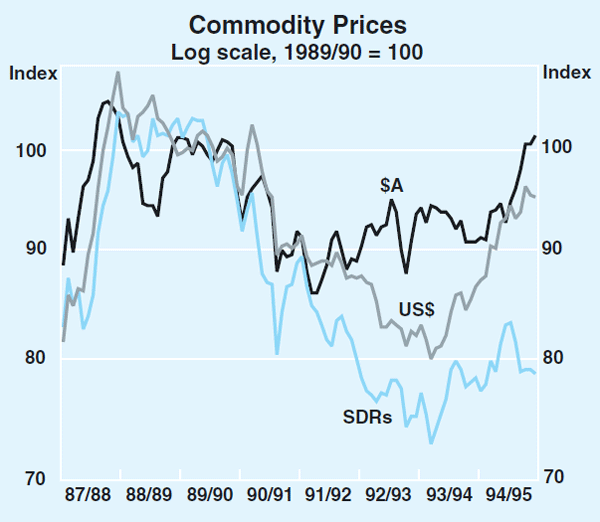
Australia's balance of payments
The current account deficit has posted some large numbers over recent months. In the three months to May, it averaged $2.5 billion per month, compared with $2.2 billion in the previous three months. Relative to GDP – the most sensible way to scale these data – the current account in the three months to May was, at a little below 6½ per cent, close to the peak in the late 1980s. The goods and services and net income and transfers deficits both widened over this period (see Graph 9). The cumulative current account deficit for the 11 months to May was $24.3 billion, which is in line with official forecasts of $27 billion for the year as a whole. The main components of the current account are shown in Table 3.
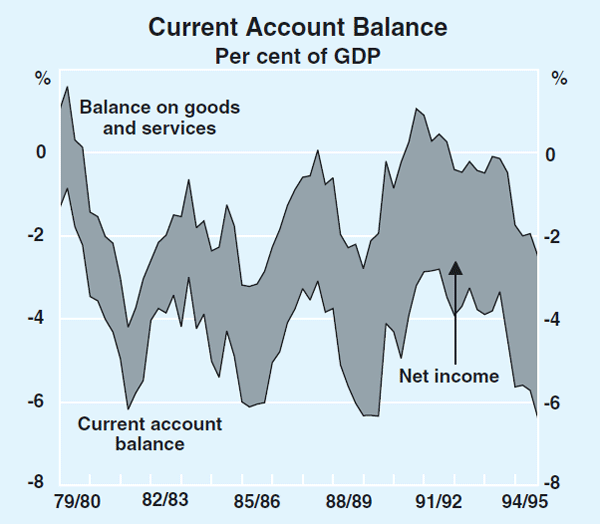
| 11 months to May (sa): | ||
|---|---|---|
| 1993/94 ($b) |
1994/95 ($b) |
|
| Merchandise exports | 58.6 | 60.7 |
| Merchandise imports | 58.9 | 68.2 |
| Merchandise trade balance |
−0.3 | −7.5 |
| Net services | −0.8 | −1.1 |
| Balance on goods and services |
−1.0 | −8.5 |
| Net income and transfers |
−14.0 | −15.8 |
| Current account balance |
−15.0 | −24. 3 |
Export volumes grew by 2.8 per cent in the March quarter, following a small fall through the second half of last year. Manufactured exports rose by 7.2 per cent, following two quarters of relatively weak growth when some diversion into the strongly-growing domestic market appears to have occurred. Resource-based exports also grew strongly, rising by 5.7 per cent in the March quarter, following little growth in earlier quarters. Service exports were little changed. Rural export volumes continued to fall, reflecting the ongoing effects of the drought, with a sharp reduction in cereal exports (see Graph 10). More recent data on export values show further growth. In the three months to May, the value of exports of goods and services was about 6 per cent higher than in the preceding three months. Growth was strongest in non-rural exports.

Imports have continued to increase over recent months. In underlying terms (excluding large lumpy items, typically of a capital nature), merchandise import volumes grew by 5 per cent in the March quarter, and 21.6 per cent over the year to March. This strong increase was driven by a large increase in imports of capital goods, and a continuing solid increase in intermediate imports.
More recent data on import values have shown further substantial increases, with underlying imports of goods and services rising by 7.8 per cent over the three months to May. Part of this increase, as in the case of export values, reflects the valuation effects induced by the falling exchange rate. While a clear picture is yet to emerge, imports of consumption goods appear to have slowed over the past six months. Growth of services imports have also weakened, while imports of capital and intermediate goods have continued to grow strongly (see Graph 11).
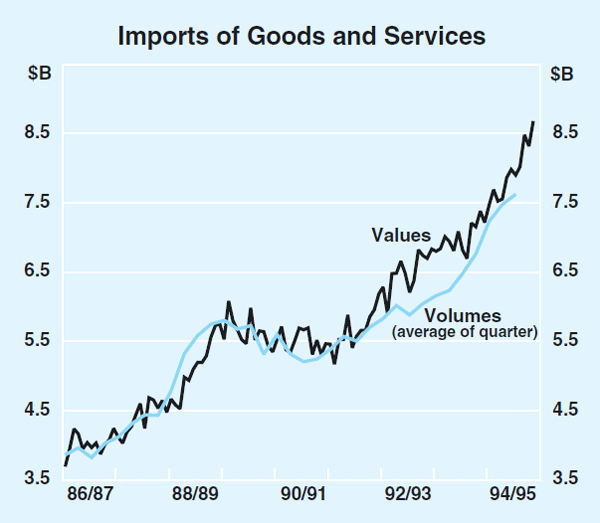
The net income deficit has risen in 1995, reflecting higher world interest rates. In the March quarter, it rose by almost $300 million. In the three months to May, it was higher again by nearly $250 million. This reflects higher interest rates prevailing around the world over the past year, which affect the net income deficit with a substantial lag.
In the March quarter, Australia's net foreign liabilities rose by $1.4 billion to around $244 billion, or 54.4 per cent of GDP. Despite equity more than accounting for all of the net inflow in the quarter, the stock of net equity liabilities fell by $2.2 billion to $77 billion (17.2 per cent of GDP) as the depreciation of the Australian dollar increased the value of Australians' equity holdings offshore. In contrast, net foreign debt in the March quarter rose by $3.7 billion to $167 billion (37.2 per cent of GDP) (see Graph 12). This was also primarily associated with the depreciation of the Australian dollar, which increased the value of debt liabilities by more than that of assets. The foreign debt service ratio remains low. Net interest payable in the March quarter was equivalent to 11.4 per cent of exports, slightly higher than its trough in late 1993, but a little over half of its peak in 1990.
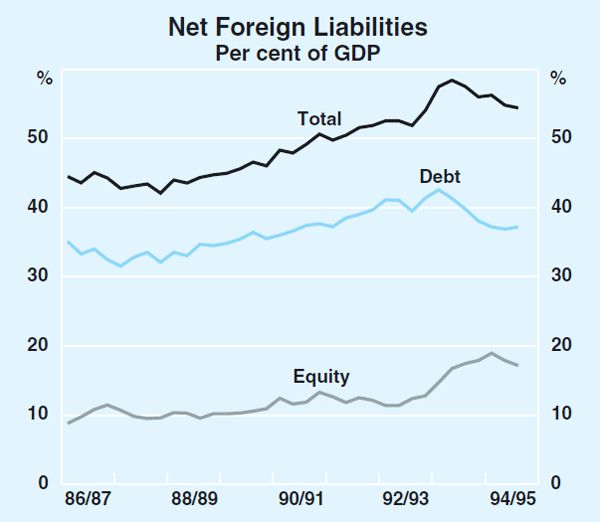
The year ahead should see some decline in the trade deficit, as slower growth reduces the demand for imports. Equipment investment is likely to continue increasing, but at a reduced pace. Import volumes could slow substantially, although part of this will be offset by valuation effects if lower levels of the $A are sustained. The easing of the drought will boost rural exports, and the fall in world interest rates over recent months should also help to contain any rise in the net income deficit.
Inflation Trends and Prospects
Recent price data
The Treasury measure of underlying inflation was 0.3 per cent in the March quarter, and 1.9 per cent over the year to March. On this basis, underlying inflation has been in the 2–3 per cent range for about four years. Broader price deflators derived from the national accounts are pointing to similar rates of increase.
The published Consumer Price Index, which is not a good guide to trends in underlying inflation, rose by 1.7 per cent in the quarter and by 3.9 per cent over the year to March (see Graph 13). Over half of the increase in the March quarter can be attributed to the effect of higher interest rates on households' interest payments. Mortgage interest charges increased by 13 per cent and consumer credit charges increased by 4 per cent in the March quarter. These increases primarily reflected increases in official interest rates in late 1994. In the June quarter, interest charges are expected to make a further, though smaller, contribution to inflation as measured by the CPI. The increase over the year to June is expected to be in the 4–5 per cent range.
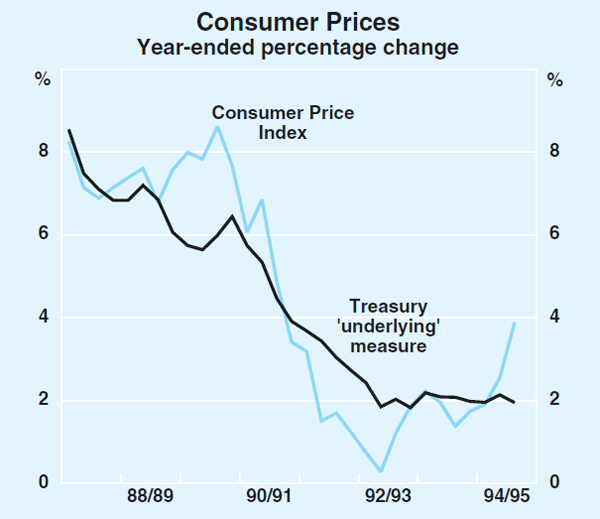
While the March quarter outcome provided no evidence of a pick-up in underlying consumer price inflation, increased cost pressures are being felt by many firms. Recent monthly increases in manufacturing input and output prices have been the largest for several years. Increases for imported input prices (excluding petroleum), like those for broad measures of wholesale import prices, have picked up markedly in the last three months, largely in response to the depreciation of the exchange rate since December. In April, the prices of imported manufacturing inputs (excluding petrol) and the import price index were, respectively, 10.8 and 4.3 per cent higher than a year earlier, reflecting price rises across a wide range of items (see Graph 14). The prices of domestically-produced materials used in manufacturing are also rising at relatively strong rates. This reflects mainly higher agricultural prices resulting from the drought and the higher world cost of metals, although prices for a wide range of inputs are now rising faster than the average for recent years. Following recent rains, further price rises for some agricultural products are likely as re-building of herds begins to take place.
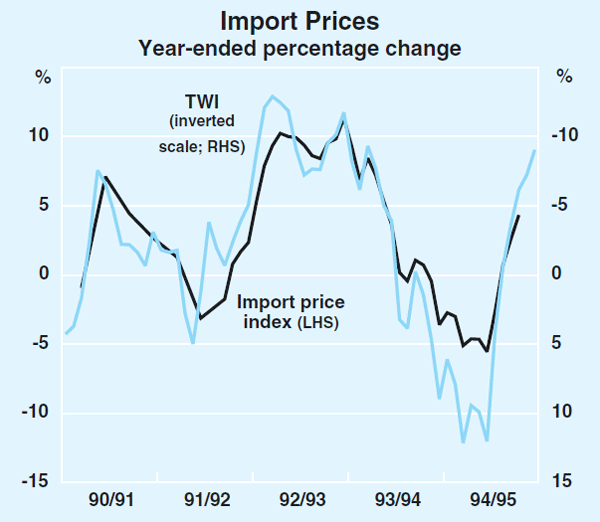
Manufacturing output prices (excluding petrol) rose by 4 per cent over the year to April. Once again, price increases for food and base metals were mainly responsible, but prices of ‘other’ manufacturing outputs have picked up over the past six months (see Graph 15). These trends suggest that manufacturers' margins, which have been at historically high levels over the past couple of years, are starting to be squeezed.
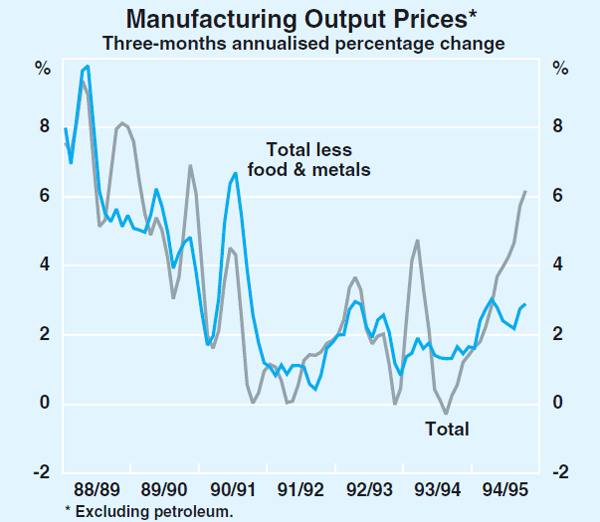
Oil prices averaged about US$19.40 per barrel in the June quarter, about US$1 higher than in the March quarter. Prices rose early in the quarter with the threat of a shortfall in US supply, but have declined recently in response to the possibility that OPEC countries may boost production to regain lost market share. At the end of June, West Texas Intermediate crude was selling for US$17.59. The depreciation of the Australian dollar over recent months has led to a substantial rise in oil prices in $A terms. In the three months to April, the oil price component of manufacturing inputs rose by 8.7 per cent, and contributed 1.5 percentage points to the 4.1 per cent rise in total manufacturing input prices. So far higher oil prices have had a relatively small effect on producer output prices, although some lagged effects can be expected.
The rate of increase in the prices of construction materials, on the other hand, appears to have moderated in recent months. In the case of house building materials' prices, in particular, increases are noticeably below those seen for much of 1994, reflecting the downturn in housing activity. Various price measures are presented in Table 4.
| Mar 1993 | Mar 1994 | Latest | ||
|---|---|---|---|---|
| Consumer Prices | ||||
| Consumer Price Index | 1.2 | 1.4 | 3.9 | Mar 1995 |
| Treasury underlying measure | 2.0 | 2.1 | 1.9 | Mar 1995 |
| Private consumption deflator | 1.9 | 1.4 | 2.2 | Mar 1995 |
| Producer Prices | ||||
| Manufacturing input prices (excl. petroleum) |
2.9 | 1.6 | 7.2 | Apr 1995 |
| of which: | ||||
| domestic | 1.8 | 2.3 | 4.7 | Apr 1995 |
| imported | 4.6 | 0.4 | 10.8 | Apr 1995 |
| Manufacturing output prices (excl. petroleum) |
2.1 | 1.7 | 4.0 | Apr 1995 |
| House-building materials | 2.9 | 4.6 | 3.1 | May 1995 |
| Other building materials | 0.8 | 1.4 | 3.0 | May 1995 |
| Import Prices | ||||
| Import price index | 8.4 | 1.1 | 4.3 | Apr 1995 |
| Imported items in the CPI | 1.5 | 2.7 | 2.1 | Mar 1995 |
| Nominal Labour Costs | ||||
| Average weekly earnings | 2.0 | 2.1 | 3.6 | Feb 1995 |
| Ordinary-time earnings | 0.8 | 3.1 | 4.4 | Feb 1995 |
Wages and the labour market
Employment growth has been very strong in the first half of 1995 when a net 150,000 jobs, almost all of them full-time, were created. Over the year to May, employment grew by 350,000 or 4.5 per cent (see Graph 16).
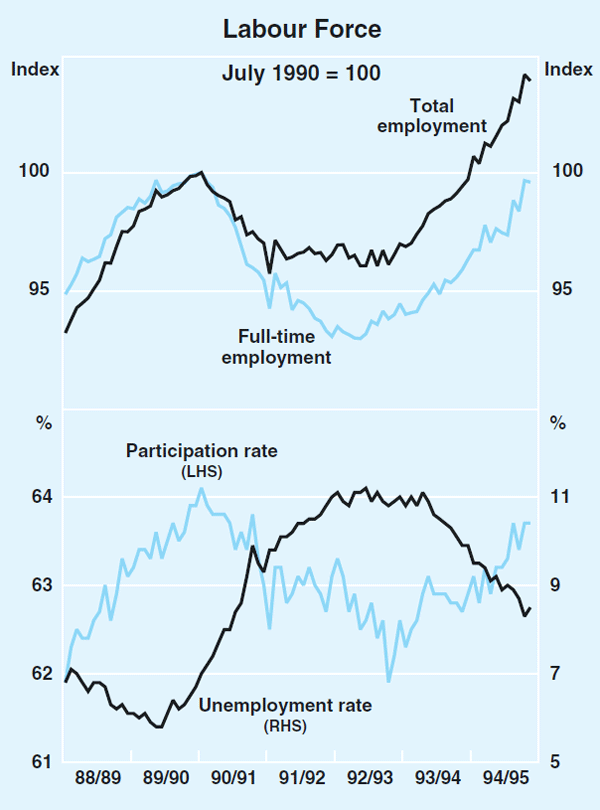
The unemployment rate has fallen to 8.5 per cent in May, compared with 9 per cent in January. The number of long-term unemployed (those unemployed for more than a year) has fallen by about one-third since November 1993 and currently constitute about 2.7 per cent of the labour force. Encouraged by the strong employment growth, labour force participation has continued to increase, and now stands at 63.7 per cent, up from 63.2 per cent six months ago.
The recent employment data, which are as strong as any seen in this recovery, do not sit easily with signs of slower output growth. Other indicators of the labour market, however, suggest some slowing in employment growth is in prospect. Vacancies, for example, have been at lower levels in recent months. The ANZ Bank's measure of newspaper job advertisements has fallen in three of the last four months, and is down by 6 per cent since November. The ABS measure of job vacancies rose by 4.5 per cent in the three months to May, with private sector vacancies up 9 per cent, but this followed a 21 per cent decline in the previous three months. The DEET measure of skilled vacancies in the three months to June was down by 13 per cent compared with the previous three months. Average weekly overtime hours per employee also have fallen over recent quarters as growth of the economy has slowed.
Although employment growth looks set to slow, the tightening of the labour market over the past year or two appears to have had an effect on labour and staff costs. Earnings data for February indicate that average weekly ordinary-time earnings of full-time adults (AWOTE) increased by 4.4 per cent over the year to February; average weekly total earnings of all employees rose by 3.6 per cent in the same period. Estimates of the split between public sector and private-sector ordinary-time earnings suggest that the pick-up in earnings has been more noticeable in the private sector, rising by 2 per cent (nsa) in the three months to February, bringing the increase over the year to February to 5.6 per cent (see Graph 17). Growth in public-sector earnings has been relatively modest over the past year. Several campaigns are under way at present.
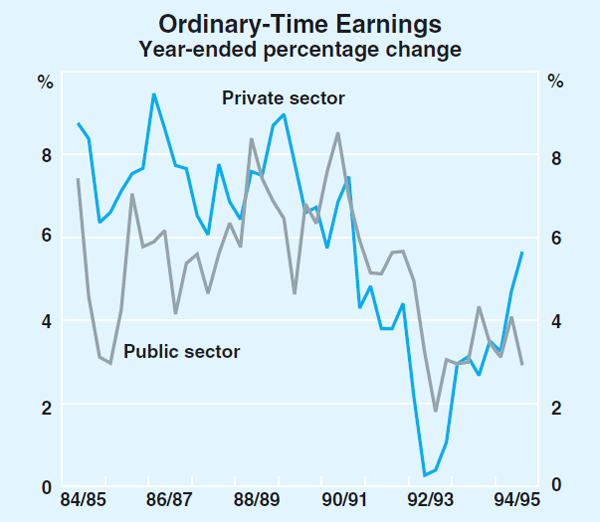
The industry breakdown of wage data in the AWE survey suggests that increases in wages have been largest in construction, manufacturing, transport and storage (each up by about 8 per cent over the last year) and wholesale trade (6.1 per cent). Most of these industries have recorded strong growth in output over the last year, and have also seen industrial campaigns at an industry level and active bargaining at an enterprise level. Managerial and executive salaries have continued to rise slightly faster than the average for all workers. The Cullen Egan Dell Quarterly Salary Review estimates that the base salaries of senior managers increased by 5.9 per cent over the year to March. Total remuneration of senior managers, which includes the cost of various fringe benefits, has risen at a slightly slower rate (5.4 per cent).
The national accounts measure of average earnings continues to lag behind survey-based measures of earnings, with the former indicating that average non-farm earnings have risen by only 2.2 per cent over the year to the March quarter. This divergence can be explained largely by recent movements in supplements and irregular payments, which are included in wages, salaries and supplements in the national accounts but not in the average weekly earnings survey. Adjusting for these factors, the national accounts average earnings figures look to be running at annual rates of around 3 per cent. Measured on a per hour basis, over the year to March the increase was around 4 per cent.
Slower output growth, if it results in reduced labour market tightness over the coming year, will be conducive to containing the pick-up in wage and salary growth. It is too early to judge the extent of this reduction at this stage. Looking further ahead, however, the Accord Mark VIII agreement between the Government and the ACTU, announced in June, will be an important factor in conditioning aspirations of wage and salary earners. It contains numerous elements, but a key one, from the point of view of monetary policy, is that the Accord partners have committed themselves to seeking wage and salary outcomes consistent with maintaining an underlying rate of inflation of 2 to 3 per cent on average over the cycle.
Inflation expectations and outlook
Forecasts for CPI inflation reported by Consensus Economics in June remain at 4.3 per cent for 1995 as a whole and have edged down a little, to 4.1 per cent, for 1996. Most private sector forecasts for underlying inflation for the year to June 1996 lie in the range of 2½ to 3½ per cent. Consumers' expectations about inflation, measured in the Melbourne Institute Survey, do not appear to have responded to the higher CPI inflation rate to date; the median expectation was 5 per cent in June, and has been in the 4–5 per cent range for several years.
Increased capital expenditure over the last two years, combined with a recent slowdown in the growth rate of sales and output, suggest that capacity utilisation has stabilised (or even fallen a little) over the last six months (see Graph 18). This is most pronounced in manufacturing, with the June ACCI-Westpac survey suggesting a distinct fall in capacity utilisation – though it remains at a relatively high level. Fewer firms now report capacity as a major constraint on increasing production. For the time being, at least, the prospect of mounting pressures on available capacity has receded considerably.
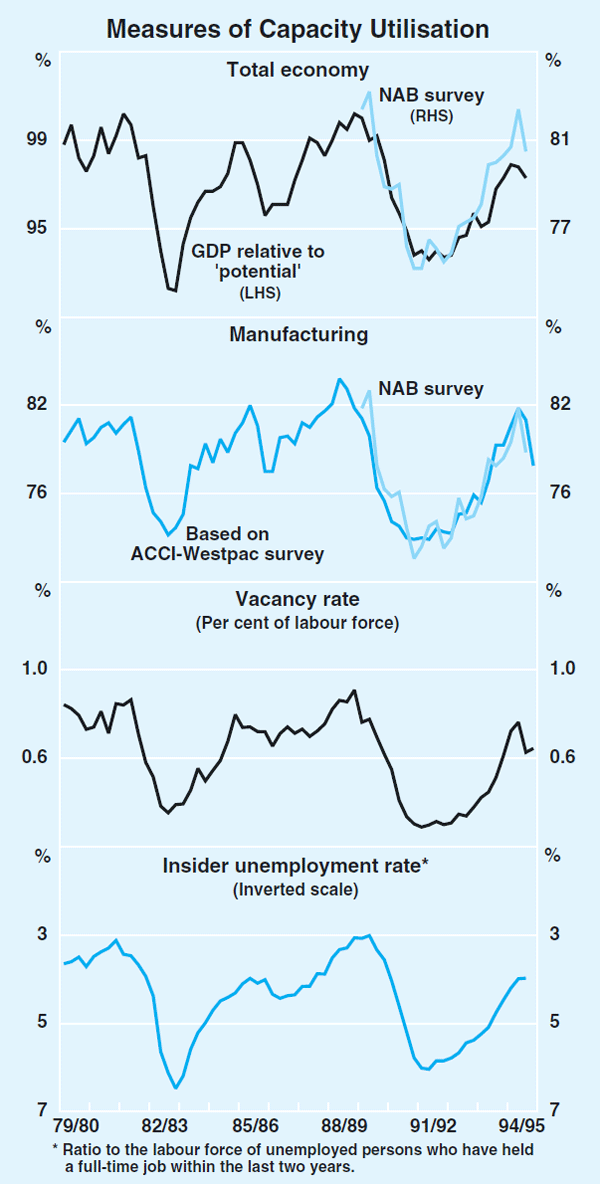
The slowing of the economy also lessens businesses' ability to pass on cost increases. In recent business surveys, a smaller proportion of firms expecting to increase selling prices actually did so than had been the case at the end of 1994.
Costs continue to rise, however, as documented above. The net proportion of firms in the ACCI-Westpac survey reporting increased unit costs rose again in the June quarter, with just under half of the firms surveyed reporting that they faced higher costs (see Graph 19). A slightly lower proportion expect costs to rise in the September quarter.
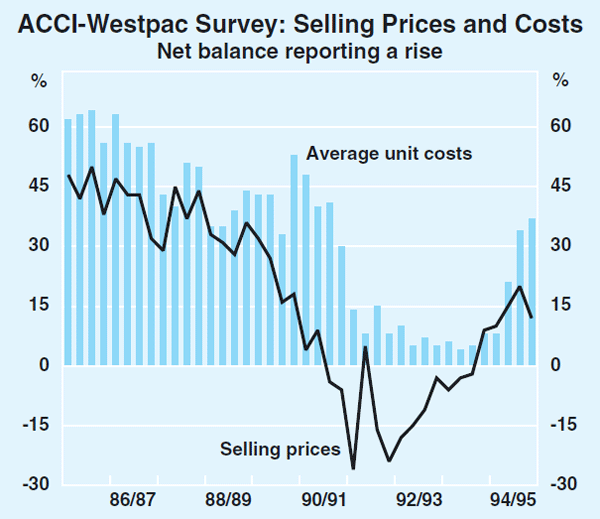
At the same time, the exchange rate has continued to drift lower. Over the last three months, it has averaged 49.7 against the trade-weighted index, compared with 54.6 in the last three months of 1994. This has already resulted in a substantial increase in wholesale import prices and further rises can be expected over the next few months. The pass-through into consumer prices will take a good deal longer, and its extent will be influenced by the trend in demand conditions.
Labour costs are increasing faster than a year ago. Productivity improvements in that time have been good, but it may be more difficult to achieve productivity gains as output slows. An easing in labour market tightness should help to ease wage and salary pressures in time, and the Accord will play an important role in containing medium-term pressures. In the short term, however, the momentum built up over the past year has still to run its course.
Finally, the indirect tax increases announced in the Budget will add something to the CPI, including (to a lesser extent) to measures of underlying inflation.
Given these factors, the outlook is for underlying inflation to move up over the coming year, with the prospect that it will temporarily exceed 3 per cent. This prospect has to be factored in, along with the outlook for activity and other relevant factors, to on-going assessments of the appropriate stance of monetary policy. (An attachment to this article restates the reasons why the Bank focuses on underlying inflation).
Financial Markets
International developments were again the main influence on Australian financial markets in the June quarter, when they exerted generally downward pressure on most interest rates. Of most significance was growing evidence of a slowing in the US economy, which reduced concerns about inflation, and encouraged expectations that US monetary policy might be eased in the months ahead. These expectations were fulfilled on 6 July when the Federal Reserve announced a cut in the Fed funds rate of 0.25 of a percentage point, to 5.75 per cent. Reflecting these developments, US interest rates fell across the board. From end March to 7 July, yields on 10-year bonds fell by 1.2 per cent to 6.0 per cent, and the yield on 90-day bankers' acceptances fell to about 5.65 per cent, a little below the Fed funds rate.
The interest rate structure in the US is now markedly different from that in late 1994. At that time, markets were expecting further significant rises in official interest rates and the yield curve was strongly upward sloping, particularly for maturities out to 2 years (see Graph 20). Now, the yield curve has a negative slope at the short end, and is a lot lower overall.
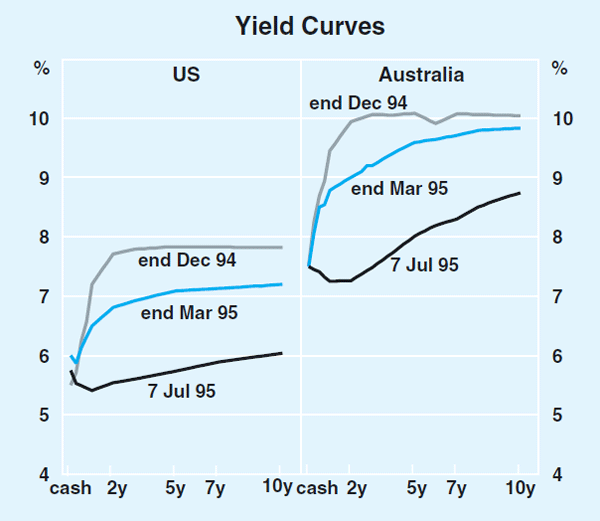
As has been the pattern over the past eighteen months, developments in the United States again dominated bond markets elsewhere. Bond yields in all major countries fell during the quarter (see Graph 21). In Japan, they fell to very low levels – 2.6 per cent – reflecting not only international trends but the cyclical weakness in the Japanese economy and the continuing gloom about the longer-term problems of the Japanese banking system.
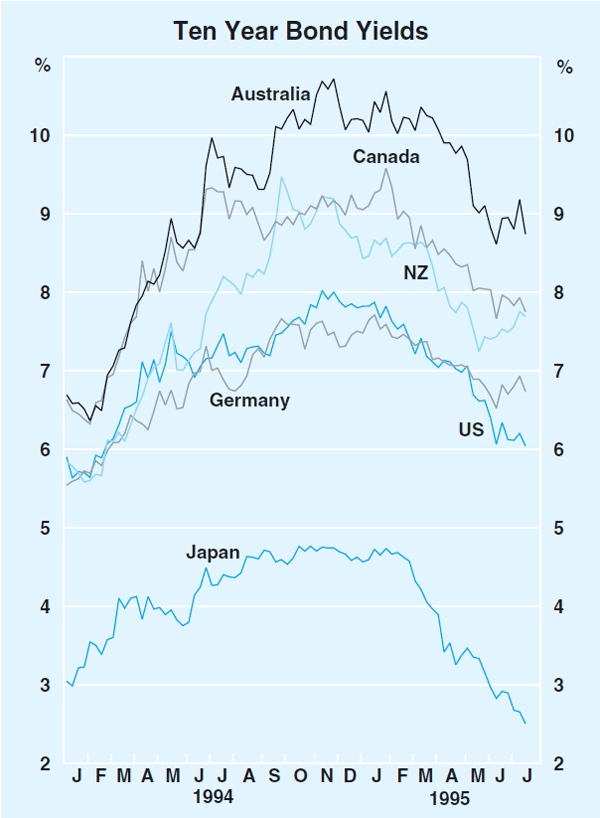
Monetary policy in Japan was eased again early in the June quarter as part of a package of measures aimed at halting the yen's rise and stimulating the economy. The Bank of Japan cut cash rates by 0.5 of a percentage point to 1.3 per cent in mid April. This followed a similar cut in March. Following the Fed's action in early July, the Bank of Japan again lowered cash rates by 0.5 of a percentage point to 0.8 per cent. In Canada, the target for cash rates was lowered by a total of 1.0 percentage point to a range of 6.75–7.25 per cent, in response to evidence of slowing growth, on the back of the slowing in the US. Sweden, Italy and Spain all tightened policy further in response to weak exchange rates and increasing inflation. As downward pressures on their exchange rates abated, authorities in France and Denmark took opportunities to lower official interest rates.
Against this international backdrop, yields on Australian securities fell during the quarter. This influence was reinforced by signs of slower growth in the domestic economy, continuing low inflation, and the May Budget. The Budget was received favourably in fixed interest markets, in part reflecting the projected sharp fall in the volume of new bonds to be issued in 1995/96. Government bond issues in the year ahead are estimated to be about one quarter of the $20 billion issued in 1994/95.
These positive factors were offset in some degree by concerns about the current account deficit, which were most pronounced at the end of June when the publication of the record May figure saw bond yields rise sharply. Bond yields had fallen from 9.9 per cent at the start of the quarter to 8.75 per cent during June before retracing to about 9.2 per cent. The cut in official interest rates in the United States in early July had a favourable effect on bond yields in Australia which subsequently returned to around 8.75 per cent.
The deterioration in the bond market at the end of the June quarter meant that the differential relative to US bonds was again higher than three months earlier. It stood at about 300 basis points. This compares with 270 points at the end of March, 220 points at the end of December and 60 points in early 1994, before the upswing in bond yields began. Given Australia's low inflation rate (which is significantly below that of the US), the differential should probably be seen essentially as an indication of the unease among investors about Australia's current account deficit.
Yields on short-term securities in Australia also declined through the June quarter as most people began to believe that the interest rate cycle might have peaked (see Graph 22). Early in June, short-term security yields briefly fell below the cash rate of 7.5 per cent as the possibility of a monetary policy easing was factored in, but this possibility soon evaporated. At the end of the quarter, yields on short-term securities were roughly on a par with the cash rate, in marked contrast to the situation at the beginning of the quarter when 90-day bill yields were at a premium of about half a percentage point to cash. The situation at the end of the quarter suggested a market expectation of steady cash rates over the period ahead. Short-term interest rates were last steady with cash in early June 1994.
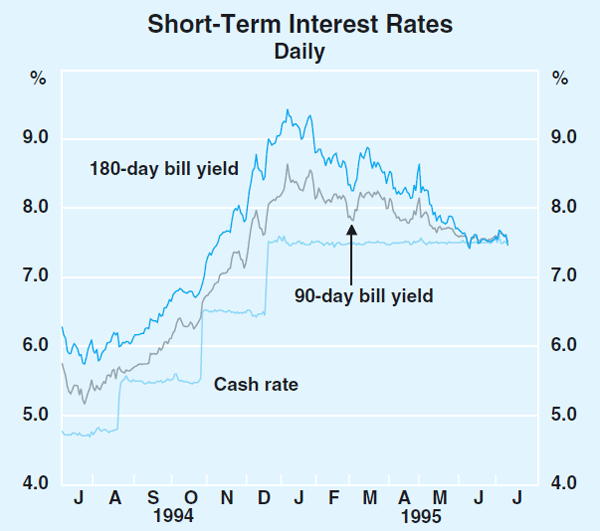
Most influences on the exchange rate, both foreign and domestic, were negative during the quarter. Slowing US growth meant a less favourable outlook for commodity prices and reduced expectations of rises in interest rates. While the Budget was received positively in the bond market, this did not carry over to the foreign exchange market. The announcement of the Budget surplus was overshadowed by forecasts of another large current account deficit in 1995/96, and by the imports and current account numbers for May which were released during June.
The Australian dollar ended the quarter at its lowest level since late 1993 in trade-weighted terms (see Graph 23). Since the beginning of 1995, it has fallen by 13 per cent in trade-weighted terms; against the US dollar it has fallen by 8 per cent.
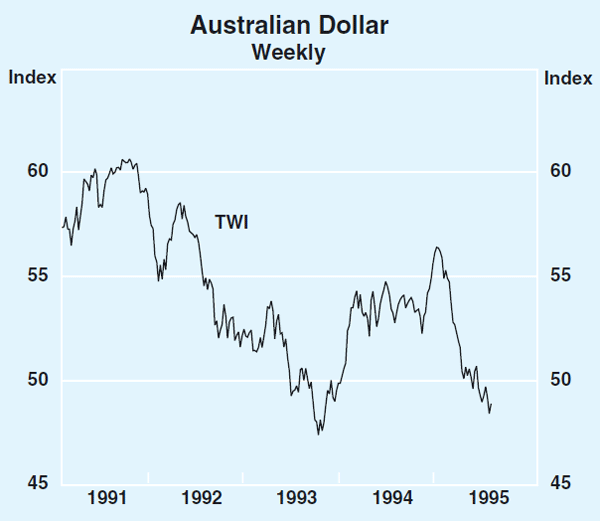
The US dollar remained weak during the June quarter, after the sharp falls in the previous quarter (see Graph 24). There was an intense bout of weakness against the yen early in April, reflecting continuing trade tensions between the United States and Japan. Concerted central bank intervention late in May gave some temporary support to the US dollar. Over the June quarter, it fell by over 2 per cent against the yen but rose by 1 per cent against the mark.
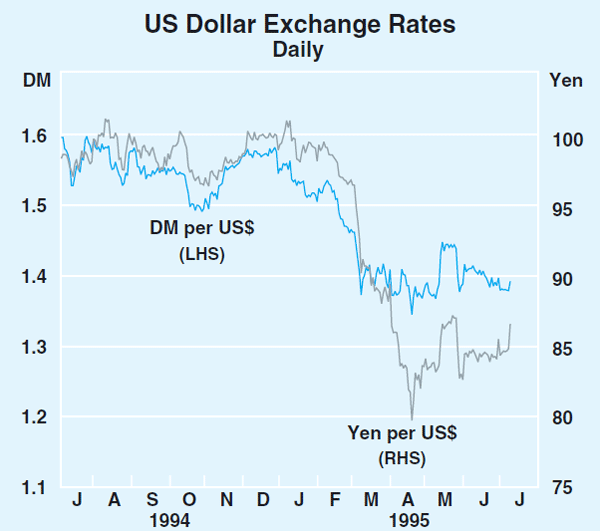
Share prices in Australia started the quarter on a positive note after a weak March quarter (see Graph 25), buoyed by the strong US share market and lower bond yields domestically. By budget day, share prices had risen by 9 per cent from the start of the quarter, to their highest level since September 1994. The market reacted negatively to corporate tax increases contained in the Budget, however, and share prices retreated. The fall continued through most of June as investors revised down their expectations of earnings in a prospectively more subdued economy. Concern about the adverse effect on commodity prices of slower world growth was a further negative influence. Nonetheless, the market recorded a net rise over the quarter of 6 per cent, bringing share prices back roughly to where they started the financial year.
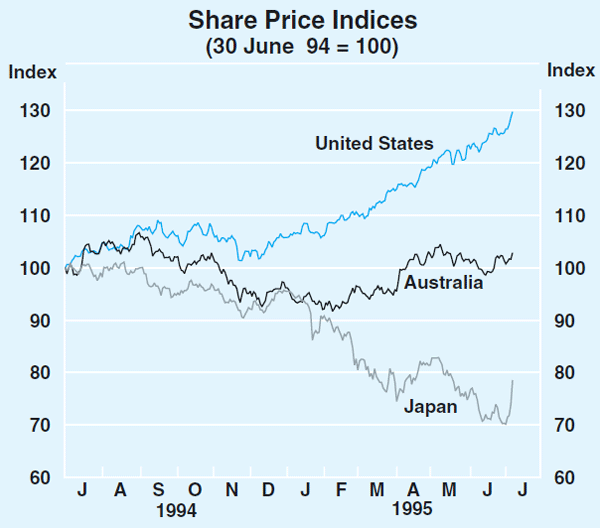
In the United States, share prices surged by 10 per cent during the quarter, reaching record highs. The rise in US share prices over the year to June was 26 per cent. In Japan, share prices recorded further sharp falls in response to continuing weak economic activity, the higher yen and concern about the stability of the financial system. Late in the quarter, the Nikkei Index fell to its lowest level since August 1992. In net terms in the June quarter, it fell by about 10 per cent and over the financial year Japanese share prices fell by 30 per cent. In early July, share prices in most countries, including most notably Japan, strengthened after the Fed and Bank of Japan cut official interest rates.
Monetary and credit growth
Growth of credit extended to the private sector by domestic deposit-taking intermediaries has picked up a little in recent months (Table 5), after a period of slower growth around the start of the year. Total credit grew at an annual rate of 9.9 per cent over the three months to May, compared with 7.4 per cent over the previous three months.
| 6 months to: | 3 months to: | |||
|---|---|---|---|---|
| Nov 1994 | May 1995 | Feb 1995 | May 1995 | |
| Credit | 10.7 | 8.6 | 7.4 | 9.9 |
| – housing | 21.5 | 12.6 | 14.1 | 11.0 |
| – personal | 7.6 | 12.6 | 10.3 | 14.9 |
| – business | 4.2 | 4.8 | 1.9 | 7.9 |
| Broad Money | 8.7 | 7.0 | 4.5 | 9.5 |
| – Currency | 6.2 | 5.5 | 4.7 | 6.4 |
| – M1 | 2.7 | 1.5 | 1.6 | 1.3 |
| – M3 | 8.2 | 5.9 | 2.7 | 9.2 |
The strongest component of credit is now personal credit, where the annualised rate of growth picked up to 14.9 per cent over the three months to May. The growth is consistent with solid consumer demand and a longer-term trend to higher levels of household indebtedness, more in line with other countries.
Growth in business credit also has picked up over recent months but remains subdued in comparison with previous cycles. Annualised growth over the three months to May was 7.9 per cent (see Graph 26). Broader measures of credit to business, which include borrowings from abroad, have been weaker than this over the past year.
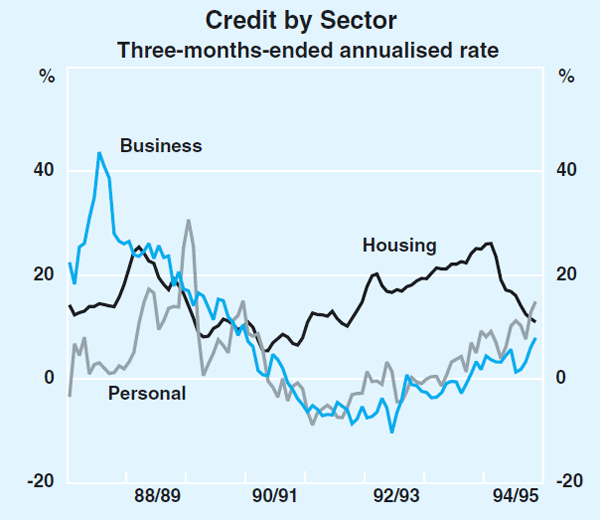
Growth of housing credit continues to moderate. Over the three months to May, it rose at an annualised rate of 11 per cent. This is broadly consistent with the large falls in new loan approvals for housing in recent months. Lending for housing could receive a modest boost from the recent falls in interest rates for some housing loans.
Interest rates on fixed-rate housing loans fell by about 1½ percentage points over the quarter on the back of falling bond yields, with banks passing on their lower funding costs. Most banks now offer 3- and 5-year fixed rates below the rates on their standard variable-rate loans; some have cut ‘honeymoon’ rates which apply during the first year of a variable-rate loan. The predominant ‘honeymoon’ rate fell by ¼ percentage point to 8¼ per cent, which is about 2¼ percentage points below the predominant standard rate.
Term lending rates for business have also fallen over the quarter, with more banks now making special offers available to business borrowers which are equivalent to discounts on standard variable rates of up to about 2½ per cent.
Growth in the broad monetary aggregates has been a little stronger over recent months. In contrast, M1, consisting of currency and bank deposits with cheque facilities, has been growing much more slowly since deposit rates began to rise in 1994. A reduction in the extent of reclassifications of deposits from fixed to current accounts has reinforced this slowdown. However, the recent falls in fixed deposit rates could see some pick-up in growth rates of M1 over the coming months. Growth in the key financial aggregates over recent months has been broadly consistent with growth in nominal GDP and movements in interest rates (see Graph 27).
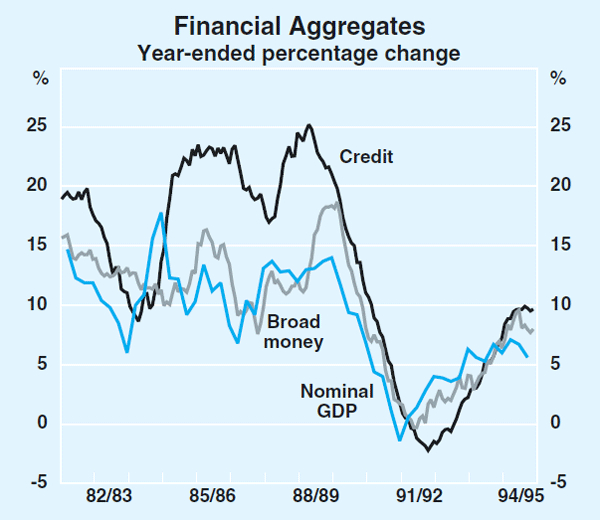
Attachment: The Focus on Underlying Inflation
For a number of years now the Bank has argued that an underlying inflation rate, rather than the ‘headline’ CPI inflation rate, is the appropriate measure of inflation to guide monetary policy and the community's inflation expectations. As in several other countries, the rationale for this is gradually being accepted by the financial markets and the community more generally. The recent Accord agreement represents an important step in the process of moving the focus from headline inflation to the underlying rate.
There is no uniquely ‘correct’ measure of underlying inflation. Any useful measure should, at a minimum, measure changes in the price of a representative bundle of goods and services of constant quality sold in the domestic economy. It should also accurately reflect the balance between supply and demand pressures in the economy, and be relatively unaffected by the direct impact of changes in administered prices or other government policy decisions. In particular, from the point of view of monetary policy, it should not be mechanically affected by changes in interest rates. Ideally, it should also not be unduly affected by the inclusion of items which are subject to volatile price movements.
The CPI does not qualify, on these criteria, as a good guide to underlying inflationary pressures. It is designed, in fact, to be a cost of living index, which at a conceptual level is not always the same as a pure price measure. One of the CPI's major drawbacks is its sensitivity to interest rates. Interest paid on mortgage and consumer debt accounts for about 9 per cent of the CPI, and with the preponderance of variable rate debt in Australia, shifts in nominal interest rates, in either direction, can change headline inflation rates significantly and obscure underlying price movements. The interest rate increases in the second half of last year directly added about 1.3 percentage points to the annual CPI inflation rate for the March quarter.
The exclusion of the direct effect of changes in interest rates from a measure of underlying inflation should not be controversial. For a start, even though there is no doubt that interest rate increases add to the financing cost of purchasing a basket of goods, households do not derive benefit from their ‘spending’ on interest payments; rather, they benefit from the goods and services that the interest payments are financing. It is the prices of these goods and services that should be included in a measure of underlying inflation. For example, if housing is to be included, it would be preferable to include the price of housing services, not interest rates, in an underlying price index. This approach is used for the CPI in a number of countries – including the US, Japan and Germany – where the price of housing services is captured using data on housing rents. In countries which include financing costs in the CPI, price indices excluding interest rate effects are usually calculated and published by the official statisticians. It is these measures which are the focus of monetary policy in those countries.
Secondly, it would clearly be inappropriate for monetary policy, in seeking to control inflation, to respond to changes in CPI inflation that were the direct result of earlier policy adjustments. Any initial increase in interest rates designed to counter inflationary pressures feeds through mechanically into higher CPI inflation. If headline inflation guided monetary policy then this would require a further policy response. This would set in train an unsustainable and perverse process in which higher and higher interest rates would be required to counter measured CPI inflation, even if underlying inflation pressures were falling.
The CPI has other shortcomings as a guide to genuine inflationary pressures from the perspective of monetary policy. These include its susceptibility to the effects of changes in indirect taxes and government-determined charges. Such changes affect the CPI inflation rate, even if underlying inflationary pressures in the economy are unchanged. Once again, it is not appropriate for monetary policy to respond to such changes, although policy-makers should respond to the second round effects of any tax changes that occur.
Similarly, it would be inappropriate for policy to respond to temporary movements in prices that reflect particular short-term market conditions but do not signify lasting price pressures. The CPI can be significantly affected by large, often temporary, movements in the prices of a few items that reflect seasonal influences or other temporary factors. The effects of the recent drought on some rural prices is a good example. Beef and veal prices fell over the 9 months to March, putting downward pressure on prices. These prices are likely to rise in the next couple of quarters as the drought breaks and farmers compete for stock to rebuild their breeding herds. Such price movements affect households' cost of living, but their volatility over short periods obscures, rather than reveals, the underlying trend in prices.
Because of these problems with the CPI inflation measure, some measure of underlying inflation is necessary for monetary policy purposes. These are often compiled from the same basic data as the CPI. The consumption deflator derived from the national accounts is sometimes used as a guide to underlying trends. Other series, such as the widely-used Treasury measure of underlying inflation, are based on the exclusion from the CPI of certain conceptually inappropriate or volatile items. A slightly different approach is to give relatively smaller weight to any price which is rising or falling in an extreme way. The ‘weighted median’ and ‘trimmed mean’ measures use this method.
The Bank has examined these (and other) measures (see the August 1994 Bulletin). Each has its own strengths and weaknesses. All of the underlying measures, however, point to very similar price movements over recent years, with underlying inflation consistently in the 2–3 per cent range and, on most measures around 2 per cent, for nearly 4 years (see Graph 28). While there is no perfect measure of underlying inflation, the Treasury measure has the advantage of being the best known over a long period, and is calculated and published by the Australian Bureau of Statistics.

The Treasury measure (like others) is not completely immune, however, from distortions associated with changes in indirect taxes. Shifts in excises on tobacco and alcohol do not affect the Treasury measure, but broader increases in sales taxes, or increases in sales taxes on items such as cars, as in the May budget, will have potential effects which need to be borne in mind. These effects, which will be significant over the year ahead, cannot easily be removed from the measure. Rather, they are best seen as one reason why underlying inflation may legitimately be temporarily higher than the 2 to 3 per cent objective, without requiring a response from monetary policy.
The Bank's focus on underlying inflation has attracted some criticism. One is that certain items which do affect the cost of living of ordinary people are removed when calculating underlying inflation. Over short periods of time, the CPI inflation rate and measures of underlying inflation can diverge quite significantly – that is precisely the point in having an underlying series. In the longer term, however, the trends in the CPI and underlying price series are indistinguishable (see Graph 29). There is no systematic understatement of inflation in the underlying measure, and there is no intention to try to make inflation look lower than it really is. On the contrary, the Bank has referred consistently to underlying inflation, even when it was higher than CPI inflation, as it has been for most of the past four years (see Graph 30).
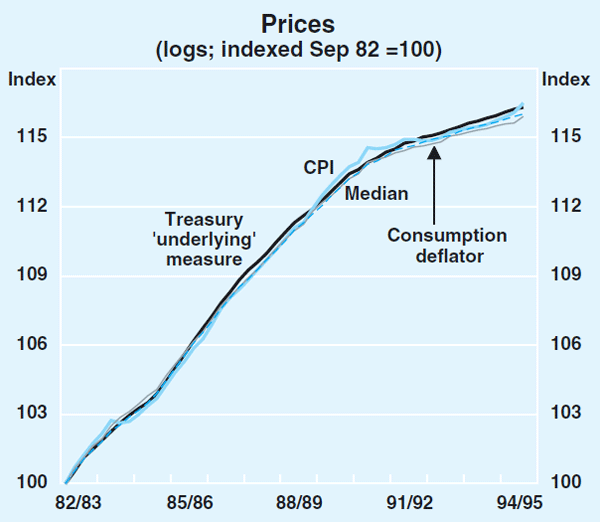
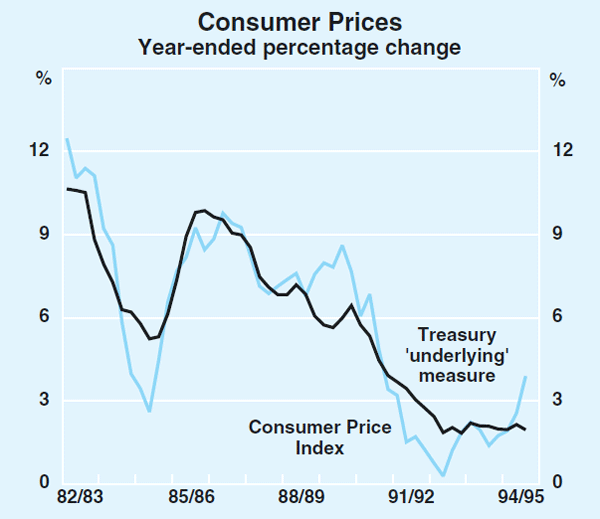
The main purpose in using underlying measures is to focus discussion and monetary policy actions on genuine demand and supply imbalances in the economy. Underlying measures also serve to emphasise the longer-term trend in inflation, and can help to prevent inflation expectations – an important driving force of inflation over the medium term – from reacting too much to short-term fluctuations in the CPI. The task of maintaining low inflation and managing the business cycle will be assisted if inflation expectations are anchored on underlying inflation, and if decision makers – including price setters – take due account of the policy objectives.